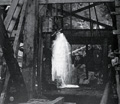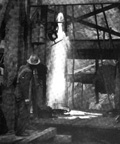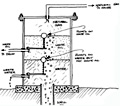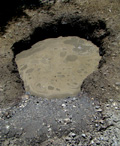|
|
Placerita 'White Oil': A Crude Wonder
By Norinne De Gal
Signal Staff Writer | February 20, 2000.
|
Placerita "white oil" was showcased at the 1876 Philadelphia World's Fair. (Webmaster's note: No, it wasn't. It was discovered in 1899.) It was as clear as kerosene and able to burn 100 times longer than conventional oil. One can only imagine it caused quite a stir. Oil production in Southern California started in the Newhall area around 1850, when natural oil seeps were crudely distilled and used as "burning oil" at the San Fernando Mission. A quarter-century later, nearby Mentryville, some six miles east of downtown Newhall, was home to California's first productive oil well, while the state's oldest refinery was located off of Pine Street and produced 20 barrels of refined product a day. But the phenomenon of Placerita white oil, a see-through form of crude oil coming straight out of the ground, is rare and occurs only in small quantities. Experts who examined it in a 1974 study for the county of Los Angeles called it "a unique geologic oddity." It is 83 percent gasoline and, according to local historians, it used to be put directly into early engines to make them run. George Starbuck grew up in the vicinity of the natural seeps. As a teen-ager, Starbuck said, he would take a 5-gallon can to his great uncle Tom Walker's white oil well, fill it up and pour the oil directly into his Model A Ford. Starbuck's grandfather, whose cabin was nearby, built a contraption on top of the well that separated the white oil from water and natural gas. Starbuck said he was not the only one catching freebies off the well. Others in the area knew about it and would fill up their tanks. Just try putting crude oil in an old Model A and see how far it runs. Close to the Placerita white oil well, another well was drilled that hit natural gas. Starbuck's grandfather laid pipes that hooked into the natural gas line. The gas was used to light natural gas lamps in the home and burned 24 hours a day. Starbuck distinctly remembers the peculiar natural gas smell in the home because the burners from the stove were kept on around the clock, too. While the natural gas and white oil occur close to each other, it is not clear how they are related, if at all. One could say Placerita white oil was refined by nature. The movement of the oil from the original source through the fine sands and clay of the San Gabriel Fault Zone created a natural filtration system for the clear, kerosene-like oil, according to the county study. Only a fraction of the original crude oil moved from the sedimentary rocks into the cracks and crevasses within the "Placerita schist" (crystalline rocks) along the Placerita Fault. Scientists have reasoned that the movement of the oil through the crystalline bedrock, creating the natural filtration system, was unusual. Placerita white oil is still bubbling up today on the grounds of the Placerita Canyon Nature Center. ©2000 THE SIGNAL | USED BY PERMISSION | RIGHTS RESERVED.
|
The site owner makes no assertions as to ownership of any original copyrights to digitized images. However, these images are intended for Personal or Research use only. Any other kind of use, including but not limited to commercial or scholarly publication in any medium or format, public exhibition, or use online or in a web site, may be subject to additional restrictions including but not limited to the copyrights held by parties other than the site owner. USERS ARE SOLELY RESPONSIBLE for determining the existence of such rights and for obtaining any permissions and/or paying associated fees necessary for the proposed use.















